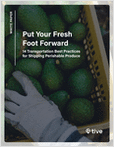 | Fruits and vegetables are more popular than ever: a 2022 study showed that sales of fresh produce in the United States rose 19% over three years—and with the perishable goods transportation market expected to grow by 7.22% a year through 2026, it’s more important than ever to have the right shipping processes in place to reduce food waste and rejections. This guide presents best practices in fresh produce shipping and the role of technology in ensuring shipments get to their destination in optimal condition. Among the tips you will learn:
Request Free! |
